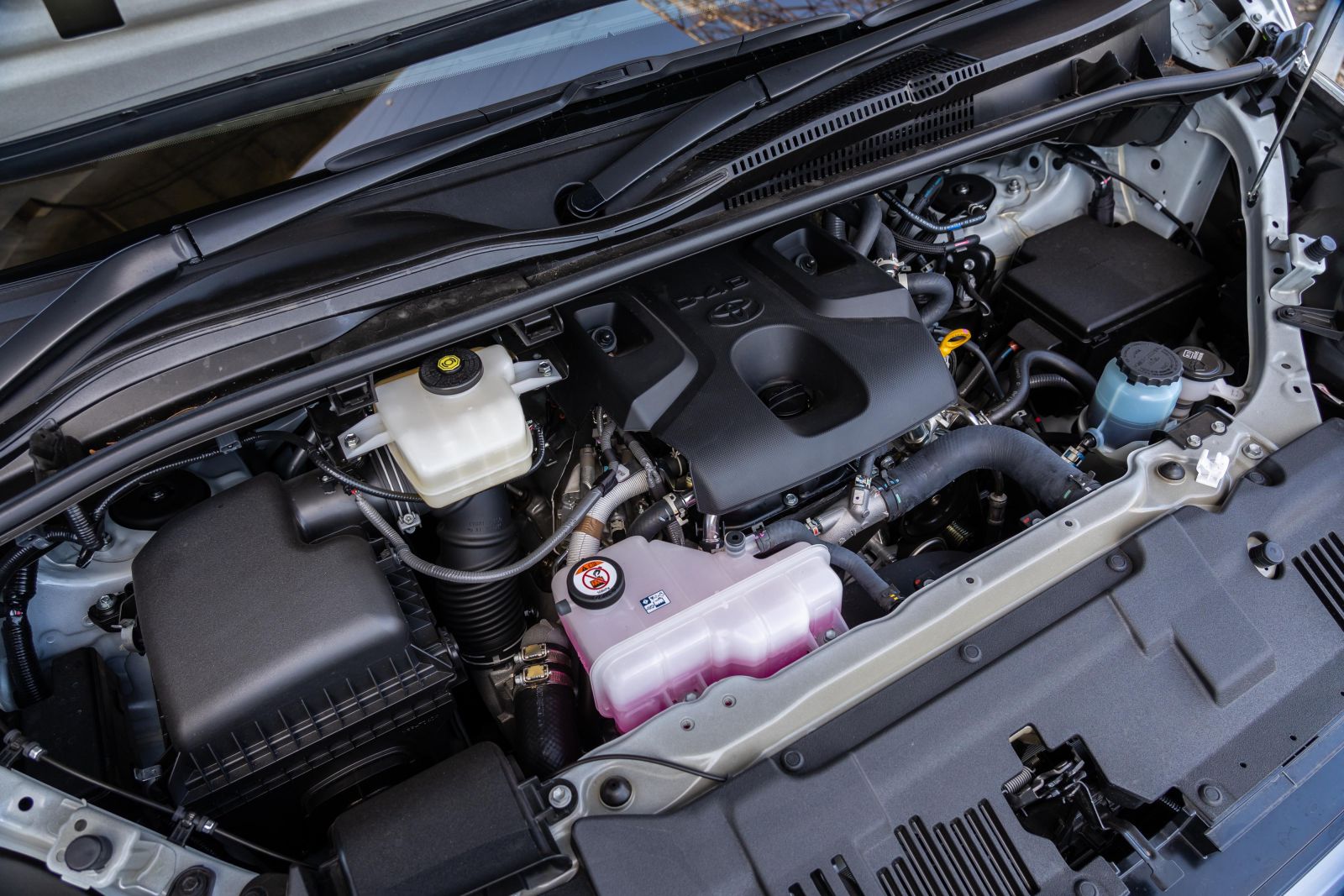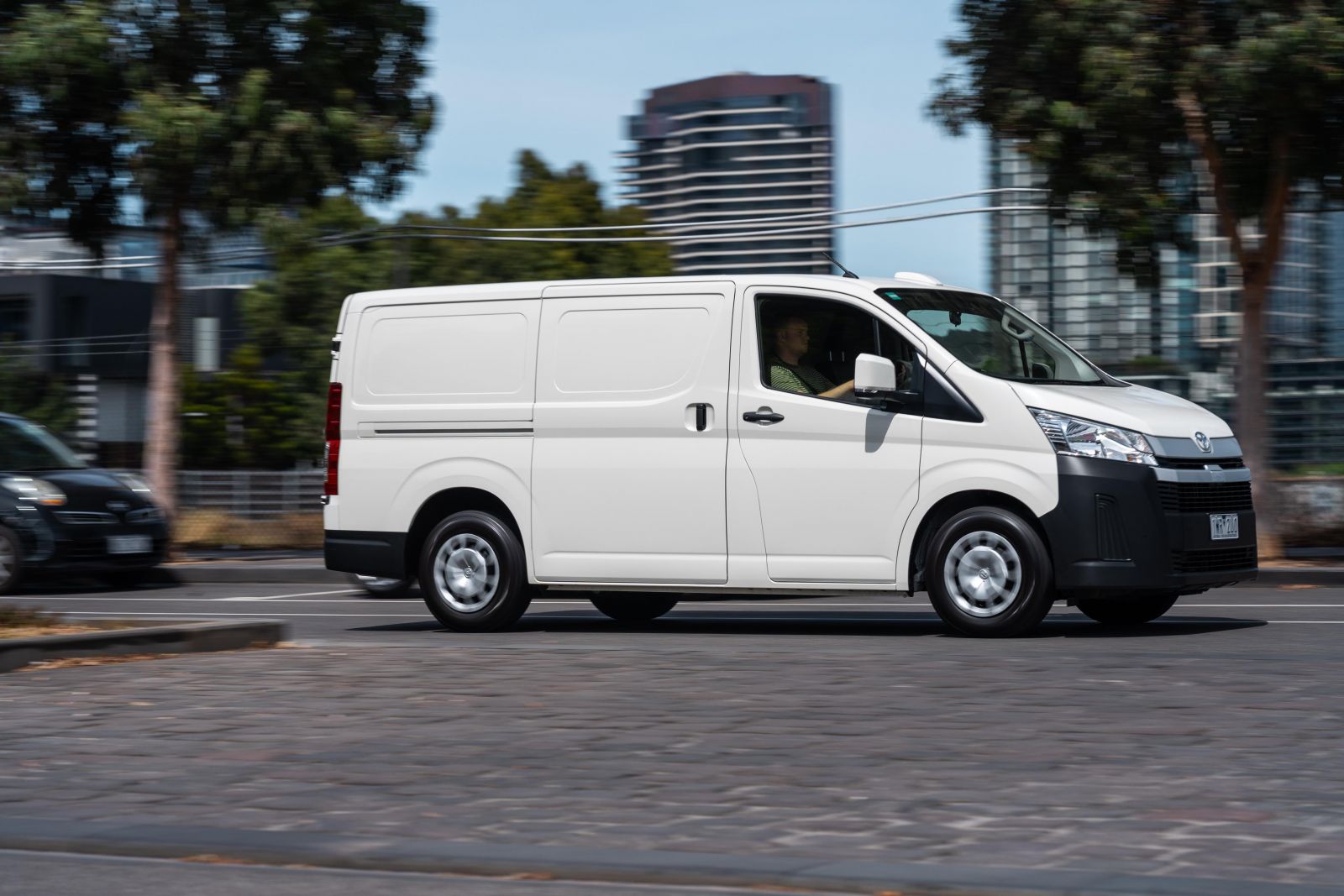Toyota has added a barn-door option to its strong-selling HiAce van after close to 20 years.
Although the HiAce offers standard dual sliding doors on its size, it’s only offered a lift-up tailgate at the rear since the HiAce SBV was axed in 2003. That’s not ideal if you need to reverse up to a raised loading dock, or want to load the van using a forklift.
The lack of barn doors hasn’t proven an impediment to sales since the latest car’s launch. It was the best-selling mid-sized van in Australia in 2020 and 2021, and retained the title in 2022 with a 37.9 per cent slice of its market.
It might not be sexy, but the HiAce remains a big deal in the van world.
Beyond the barn doors, there are no changes to the HiAce for 2023. It features turbo-diesel power as standard – the V6 was axed on the back of limited customer demand – and comes in any colour so long as it’s white.
Everything that’s been good about it since launch remains good in 2023.
How much does the Toyota HiAce cost?
The HiAce range now kicks off at $46,360 before on-road costs for a liftback model with a manual transmission, jumping to $48,360 before on-roads for the liftback with an automatic.
Opting for the Barn Door option adds $750 to the price tag, meaning our tester will set you back $49,110 before on-roads.
That aligns it with the Ford Transit Custom 340L LWB Auto ($52,390), Renault Trafic Pro LWB auto ($52,200), and Hyundai Staria Load Premium van ($51,240).
2023 Toyota HiAce pricing:
Van
- Toyota HiAce LWB Van 6MT: $46,360
- Toyota HiAce LWB Van 6AT: $48,360
- Toyota HiAce LWB Panel Van 6AT: $48,360
- Toyota HiAce LWB GL Van 6AT: $49,360
- Toyota HiAce LWB Crew Van 6AT: $51,360
- Toyota HiAce SLWB Van 6AT: $56,920
Barn Door
- Toyota HiAce LWB Barn Door Van 6AT: $49,110
- Toyota HiAce LWB Barn Door Panel Van 6AT: $49,110
- Toyota HiAce LWB Barn Door GL Van 6AT: $50,110
- Toyota HiAce SLWB Barn Door Van 6AT: $57,670
What is the Toyota HiAce like on the inside?
Before we get to the passengers, let’s talk cargo space.
The LWB model on test here measures 5265mm long, 1950mm wide and 1990mm tall, with a 3120mm wheelbase.
With a cargo bay that’s 2530mm long, 1760mm wide (1268mm between the arches) and 1340mm tall, the LWB has 6.2m3 of space in its cargo bay, compared to 9.3m3 in the SLWB.
The metal floors, wooden wall trims, and lack of a cargo divider all made the HiAce feel a bit bare, but it’s worth noting owners will immediately delve into the accessory catalogue to get their van ready for whatever work they’re doing.
Access through the barn doors is excellent, as you’d expect. You’ll need to use a manual strut to lock them into place properly at 90 degrees in tight spaces, but they’ll hold themselves when opened to the maximum 180 degrees.
Although it’s a bit bare, the HiAce is a comfortable place to spend time. There’s plenty of adjustment in the steering wheel, the seat slides far enough to accomodate long legs, and the seat padding finds a balance between comfort and support.
Visibility through the windscreen is decent, but the stubby little bonnet is hard to see which makes placing the van in tight spaces harder than it was in the old model with its vertical front end. Of course, your legs aren’t in the crumple zone this time around.
The upright dashboard is basic, but has everything the average tradie would need. There are three cupholders on the dash. A massive storage bin between the seats features here, which wasn’t the case in the manual model we drove in 2020.
It has a usable flat top, and a rubberised space at your feet. Not only does it allow you to store stuff, it provides a flat space for signing documents or handling paperwork on the move.
Toyota’s infotainment technology is serviceable, but it’s gradually being replaced across the range by a system with sharper graphics and faster responses.
Factory satellite navigation is handy for drivers delivering beyond the reach of mobile reception.
Having Apple CarPlay and Android Auto papers over some of the infotainment system’s shortcomings, although it’s not wireless as is the case in newer Toyota products.
It worked flawlessly during our time with the car, and offers far easier access to phone-quality entertainment, phone calls, and mapping.
What’s under the bonnet?
The 2023 Toyota HiAce is powered by a 2.8-litre four-cylinder turbo-diesel producing 130kW of power and 450Nm of torque with the six-speed automatic fitted to our tester.
Opting for the entry six-speed manual drops that torque output to 420Nm.
The 2023 Toyota HiAce uses a claimed 8.2L/100km in LWB auto guise, but we saw 11.2 litres per 100km on a week with a strong skew to city driving.
The fuel tank holds 70 litres.
How does the Toyota HiAce drive?
The turbo-diesel engine in the HiAce is shared with the HiLux ute, and packs plenty of torque down low.
Compared to the manual we drove in 2020, the automatic model packs 30Nm more torque. It doesn’t feel all that much quicker unladen, but every extra bit of twist helps when you’re lugging around a heavy load.
Unladen, the HiAce scoots along effortlessly. The automatic transmission shuffles smoothly through the ratios, generally keeping the revs below 3000rpm to save fuel and keep the cabin reasonably quiet.
There’s a decent serving of diesel clatter when you lean on the throttle, but it’s impressively smooth and quiet at a cruise. Even with a load on board it feels strong, despite its 2200kg kerb weight and the fact the same engine in the HiLux pumps out 20kW and 50Nm more again.
Where the HiLux ute misses out on stop/start, however, it features in the HiAce which is a win if you spend a lot of time at a standstill. It easily be turned off if you don’t like it.
Our tester was bog standard, which means there was no divider between the load bay and cabin. That means it’s very echoey in the cabin, and all the noises from the driveline that are usually muffled are audible through the floor.
It’s not an issue for owners who fit a cabin divider, and road noise was still entirely bearable at 100km/h without one. My passenger and I could chat without raising our voices, and phone calls still worked without too much trouble.
With its long wheelbase and wide track, the HiAce feels nicely planted on the highway. It doesn’t get knocked around by crosswinds, and the steering is precise enough to inspire confidence on sweeping bends.
Combined with cruise control (albeit not adaptive), the feeling of stability means eats up the miles more happily than its flighty predecessor ever could.
Unfortunately, the lane-keep assist is overzealous. Rather than steering you back between the white lines, it brakes when it detects you drifting. It’s more rudimentary than the steering assist offered elsewhere in the Toyota range, and feels very abrupt behind the wheel.
The larger body on the new HiAce makes itself known in town. The old model was easy to pilot because the driver sat at the very front of the vehicle. At 1950mm wide, the new model is also 355mm broader than the car it replaces.
With a widescreen view out the front, large mirrors, and commanding driving position, you can still thread the HiAce through the city with relative ease though. The light steering makes manoeuvring through laneways or tight loading docks a breeze, and the reversing camera is good enough that it’s handy to have if you’re trying to line up a trailer.
The turning circle is excellent, relative to the vehicle’s size. You’ll be surprised by how often a U-turn will suffice where a three-point turn may have been necessary.
What do you get?
All HiAce models seat two occupants, except the Crew Van which seats five and the Commuter which seats 12.
New for the 2023 model year is the option of rear barn doors that replace the single tailgate with a pair of vertically split doors, which on LWB models include dual rear wipers.
HiAce highlights:
- 16-inch steel wheels
- Full-size spare wheel
- 8.0-inch touchscreen infotainment system
- Wired Apple CarPlay, Android Auto
- Bluetooth
- DAB+ digital radio
- Satellite navigation
- 4.2-inch instrument cluster display screen
- Front USB port
- Cruise control
- Leather-accented steering wheel
- Driver powered lumbar support
Is the Toyota HiAce safe?
The last HiAce wasn’t known for its crash safety, but the new one launched with the goal of changing that.
It has a five-star ANCAP safety rating based on testing carried out in 2019. It earned a 94 per cent score for adult occupant protection, 88 per cent for child occupant protection, 84 per cent for vulnerable road user protection, and 77 per cent for safety assist.
Standard safety equipment includes:
- Autonomous emergency braking (AEB)
- Pedestrian detection (day/night)
- Cyclist detection (day)
- Blind-spot monitoring
- Lane departure warning
- Lane keep assist
- Rear cross-traffic alert
- Automatic high-beam
- Traffic sign recognition
- Reversing camera
- Front and rear parking sensors
The majority of the 2023 Toyota HiAce range has seven airbags, besides the LWB Crew Van which has nine. The Commuter has three.
The HiAce range also received Toyota Connected Services for 2022, which includes a 24/7 Emergency Call Centre function that relays the vehicle’s location in the event of a collision “that requires intervention” or if an airbag deploys.
The e-call function can also be triggered manually via a SOS button inside the cabin.
How much does the Toyota HiAce cost to run?
Toyota backs its vehicles with a five-year, unlimited-kilometre warranty, extended to seven years on the drivetrain if you service within its dealer network.
Capped-price servicing is offered for the first six visits, required every six months or 10,000 kilometres.
It’s a shame owners have to visit the dealer twice per year, especially considering the fact van drivers are generally reliant on their vehicles for work. Each service is capped at $260.
CarExpert’s Take on the Toyota HiAce
The HiAce is a strong seller for a reason.
It was already refined, safe, and practical; the addition of barn doors has only made it more so.
Although the death of the V6 petrol engine and exterior colour options have narrowed the range, the turbo-diesel is a smarter option for most operators and aligns the HiAce better with its diesel-only rivals.
Issues? The six-month service intervals are too short for private owners, let alone professional operators reliant on their vehicles to earn money. It’s the only real blight on what’s otherwise a very capable van.
Click the images for the full gallery
MORE: Everything Toyota HiAce













